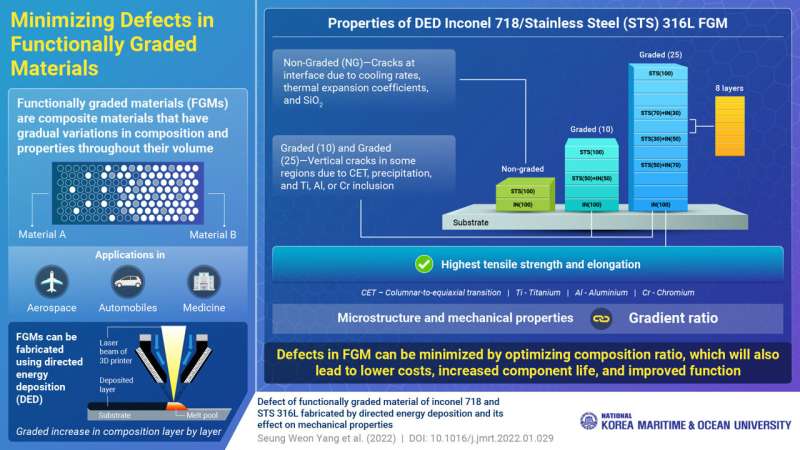According to the study, manipulating the gradient ratio of the component materials during directed energy deposition (a 3D printing technique) can lead to high-performance functional materials with minimal defects. Credit: National Korea Maritime & Ocean University
Materials used in the fields of aerospace, automobiles, medical equipment and defense need to withstand extremely harsh environments. Small flaws in the materials, i.e. cracks, can lead to catastrophic consequences and massive economic loss. However, most materials cannot handle such high temperatures and pressures. Multimaterials, like functionally graded materials (FGMs), which combine different materials to produce improved performance, are ideal in these situations.
Multimaterials are normally made by additive manufacturing (AM), where layers of different materials are deposited one over the other. However, cracks and pores are common at the boundary layers due to the different properties of the materials. FGMs seek to reduce these cracks by creating a 'gradient' to the composition change across the volume of the material. Now, researchers from Korea Maritime and Ocean University have developed a way to synthesize a high-performance FGM made of Inconel 718 and stainless steel (STS) 316L and minimize its defects.
According to Professor Do-Sik Shim, who led the study, "Inconel 718 has excellent properties, but it is expensive. By mixing it with STS 316L to create a high-performance FGM, we have not only improved its technical and commercial advantages, but its economic feasibility as well." Their findings are published in the Journal of Materials Research and Technology.
For their work, the research team deposited STS 316L onto Inconel 718 using a 3D-printing technique called 'directed energy deposition.' They created three types of FGMs, non-graded (NG), which involved a layer of STS deposited directly on Inconel, graded (10), and graded (25), which had mixing gradients of 10% and 25% respectively. They found that interfacial cracks were common in the NG type, whereas Graded (10) and Graded (25) had cracks only in specific regions due to 'columnar-to-equiaxial transition' (a transition in the microstructure of the FGM), precipitation, or the inclusion of titanium, aluminum or chromium impurities. They moreover saw that the Graded (25) type showed the highest tensile strength and elongation.
These findings indicate that the microstructure and mechanical properties of FGM are highly dependent upon the gradient ratio of the components, thereby creating the potential to achieve minimal or even no defects in FGMs. "These findings will lead to improvements in the field, such as reduced costs, extended component lifespans in equipment, and enhanced functionality," says Professor Shim. The research team's future plans include using the new FGM to manufacture complex shaped parts using AM technologies.
More information: Seung Weon Yang et al, Defect of functionally graded material of inconel 718 and STS 316L fabricated by directed energy deposition and its effect on mechanical properties, Journal of Materials Research and Technology (2022). DOI: 10.1016/j.jmrt.2022.01.029
Provided by National Korea Maritime and Ocean University
























